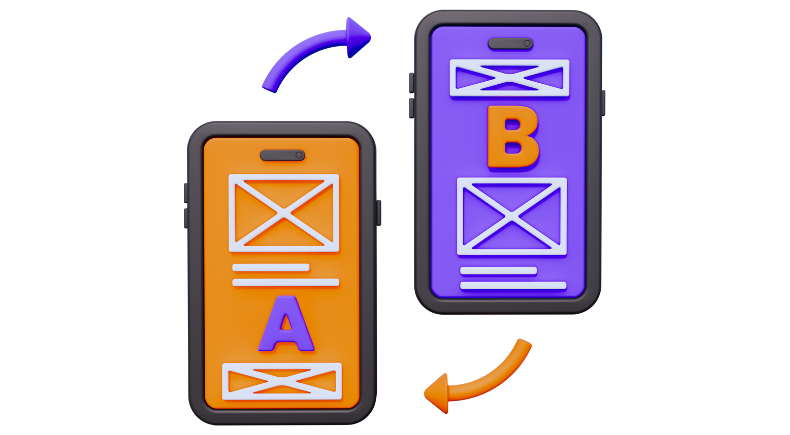Email A/B Testing Guide: What Works (and What Doesn’t)

Email marketing is all about continuous optimization, but let’s be honest… who has time to test everything? I’ve already run these A/B tests so you don’t have to.
Below, I’ll break down the most effective email A/B tests, what we learned, and how you can use these insights to boost your email engagement, conversions, and sales.
In my experience, the last point (#8) is were the really significant performance enhancements lie.
1. Subject Line Testing 📩
Your subject line is the first impression, make it count!
|
What We Tested |
Results |
|
Short vs.
long subject lines |
Shorter,
punchier subject lines get higher open rates (ranging from 3-10% higher
in ecom promotional emails) |
|
Personalization
(e.g., “Hey [First Name]” vs. no name) |
Personalized
subject lines can increase open rates by 26%. |
|
Curiosity-driven
vs. straightforward subject lines |
Curiosity-based
subject lines (e.g., “You won’t believe this...”) drove more opens but fewer click-throughs
and conversions. |
|
Emoji vs. no
emoji |
Emojis always
improve open rates sightly cause they draw attention in a full inbox. Use
sparingly because it can come across as spammy in some industries. |
2. Sender Name & Email Address 📢
Would you rather open an email from “Marketing Team” or “Ryan from Campaign Geeks”?
|
What We Tested |
Results |
|
Brand name
(e.g., “Campaign Geeks”) vs. personal name (e.g., “Ryan at Campaign Geeks”) |
Emails from a
real person’s name often feel more personal and will get higher open rates.
Try this out on a high priority campaign you want to make sure your
subscribers see. |
|
No-reply@company.com vs.
hello@company.com |
Avoiding
"no-reply" emails improves deliverability and engagement (source: Sendgrid).
However, in our case this yielded statistically insignificant results (no
winner here!) |
3. Email Copy & Tone 📝
How you write your email impacts whether people read or ignore it. Finding the right ton for your audience is important.
|
What We Tested |
Results |
|
Formal vs.
casual tone |
Conversational
emails often increase engagement and reply rates. |
|
Short vs.
long email copy |
Shorter
emails usually drive higher CTRs, but longer, value-packed emails work better
for educational content. In our test, a longer flyer style email outperformed
a shorter version. I’ve seen lots of mixed results here so make sure you test
this one out on your audience across templates. |
|
Storytelling
approach vs. direct-to-the-point messaging |
Storytelling
can increase conversions by making emails more relatable. We tested this
approach in a welcome email series and drove 12% more conversions because it
resonated more than generic “about us” content. Some great examples on how
to do this here. |
4. CTA (Call-to-Action) Placement & Wording 🎯
Your CTA determines whether subscribers take action.
|
What We Tested |
Results |
|
CTA above the
fold vs. at the end of the email |
Placing the
CTA higher boosted click-through rates (CTR) by 2-7%, depending on the template. |
|
Button CTA
vs. text link CTA |
CTA buttons
generally get higher clicks than text links. Bonus: test the CTA you’re
using on the buttons (i.e. “Shop Sale” will get more click throughs than “Shop
Now” |
|
Action-oriented
CTA (“Get Started Now”) vs. curiosity-driven CTA (“See What’s Inside”) |
“Action-driven”
CTAs often outperform vague or generic ones. |
5. Plain Text vs. HTML Design 🖼️
Pro Tip: Keep designs clean with a balance of images and text. Try not to overload with images, it can hurt deliverability.
|
What We Tested |
Results |
|
Plain text
email vs. beautifully designed HTML email |
Plain text
emails often perform better in B2B or relationship-based industries. But this
isn’t the case in B2C. So be sure to test this out to find the right fit for
your business. |
|
Image-heavy
email vs. text-heavy email |
HTML emails
with visuals tend to boost engagement in eCommerce & B2C. Too many images
can trigger spam filters, so balance is key. |
6. Send Time & Frequency 📆
When you send emails affects whether they get read or buried in busy inboxes.
|
What We Tested |
Results |
|
Morning vs.
evening send times |
Best send
times vary, but many studies suggest Tuesdays and Thursdays at 10 AM work
well. For ecom retailers I’ve worked with, sending in the evening at 7pm has
been successful, a recent test got 9% lift in open rates vs. sending
at 7am. |
|
Weekdays vs.
weekends |
For B2B,
sending in the morning on weekdays will work best. For B2C it’s a bit more
nuanced depending on the typical habits of your target market. Test sending to
your key segments in the morning and evening, I’ve seen mixed results with
B2C businesses. |
|
1 email per
week vs. 3 emails per week |
More emails
can mean more engagement… until subscribers feel overwhelmed and start
unsubscribing. Monitor your unsubscribe rates with this test. We found that
sending 3 times a week was optimal for ecommerce brands. More than this can
have diminishing returns and make a dent in your email list over time. |
7. Segmentation Optimization 🎯
Make sure you're sending the right message to the right customer.
|
What We Tested |
Results |
|
Demographics
(gender and age) |
Typically segmenting
based on gender is appropriate in B2C, but I’ve seen mixed results depending
on the business: - Vitamin
& health ecom retailer: Men subscribers had a 50% lower CTR on a Women’s
health campaign. Clearly their men subscribers weren’t interested, so we
helped make this adjustment to their segments going forward. - Beauty
& skincare ecom retailer: the result showed that men subscribers are
still engaging with traditionally female content at a high rate - only 2%
lower CTR on a makeup email. Suggested they don’t segment based on gender. |
|
Past purchase
behaviors |
Implemented a
series of tests to refine key segments for an online retailer: - Segment
based on brand & category purchased. - Test the
timeframe of when the last purchase was placed. - Segments
that show weak engagement, further refine until the engagement goal is reached. Incorporating
this approach with a baby & kids retailer helped refine the baby audience
vs. toddlers vs. kids segments, leading to an overall improvement in CTR
of 12% across all campaigns. |
|
Predictive
algorithms |
Tested fancy predictive
AI models for segmenting customers based on their most likely to purchase
category. Found that segmenting based on past purchase segment rules that
were previously established worked best… Perhaps the inputs for the predictive
model weren’t accurate, so more testing to come here! |
|
Unengaged
subscribers |
It’s important
to keep
your email list clean, so make sure you’re constantly refining your list.
Do this by splitting out sends to your least engaged subscriber cohorts to
see CTR and campaign conversions: - Subscribers
who haven’t clicked through in over 3 months. - Subscribers
who haven’t placed a purchase in over a year. If these
cohorts still aren’t clicking through, then it’s time to unsubscribe them. |
8. Personalization & Dynamic Content 🔄
Take your email campaigns to the next level by leveraging personalized content. In my experience, this is where the significant performance enhancers lie. Take some time to think about the tailored offers and recommendations you can offer to your customers based on their unique behaviors.
|
What We Tested |
Results |
|
Generic vs.
dynamically personalized email content |
All tests
including a personalization piece of content wins: - Rewards
banner for loyalty members increased conversion by 8% from the cohort. - Dynamic
banner featuring new customer coupon code to drive first purchase increased
conversions by 4%. - Shoppers
who recently abandoned cart received “Still looking for something?” content
in upcoming promotional email (dynamic banner featured outside of abandon
cart trigger email) - Calling out
customers favorite brand in promotional email SL and header increased by
23%! |
|
Including
past purchase history in emails vs. no personalization |
Recommending
products based on past purchases can increase repeat sales. We saw
significant lift across various tactics: - “Similar
Items” recommendations in abandon cart email template boosted CTR by over
15%. - “Your faves
on sale now” in weekly promotional email boosted CTR by a whopping 21%! - Including “You
may also like” recommendations in post-purchase email series boosted CTR by
8%. |
Final Thought
A/B testing isn’t about one-size-fits-all answers, it’s about continuous improvement. Test, analyze, and iterate to find what works for YOUR audience!
Word of advice: don't try to test too many elements at once. If you do want to test multiple elements make sure you set it up as a proper multivariate test, otherwise, the results will be unclear as to why the winning version actually outperformed,
If you have any suggestions on A/B tests to add to the list, let me know in the comments 😄

